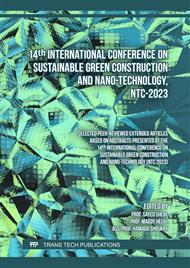p.1
p.15
p.25
p.37
SHM of Tahya Masr Cable-Stayed Bridge Using Resensys Wireless Sensors
Abstract:
Structural Health Monitoring (SHM) is now a fundamental idea in our daily lives. It is related to many disciplines, including Civil Engineering, Aerospace Engineering, Mechanical Engineering, and Marine Engineering, among others. It provides a diagnosis of the structure's state at every moment of its residual life, improves understanding of structural behavior, and detects any change that occurs to any component of it or for the entire structure via some devices (Sensors) that may be wired or wireless, incorporating micro and nanotechnology in their components putting on it or on the part under study. These sensors are data collectors that send data to a laptop or computer for processing via a communication system. These data assist decision-makers in determining the structure's residual life and whether it requires maintenance or rebuilding. The wireless SHM system of a Tahya Masr cable-stayed bridge is developed in this study using Resensys SenSpotTM Sensors. The following approaches are suggested to achieve the goal. Wireless sensors were used to measure strain and monitor vibration, strain, inclination, tilt, temperature, and humidity. These measurements help to develop a reference data set that can be used to monitor and detect changes in structural behavior that indicate damage. This study successfully assessed the viability of Resensys SenSpotTM wireless, and it provided a brief overview of vibration- and impedance-based SHM techniques appropriate for the cable-stayed bridge's pylon system. Finally, the Tahya Masr cable-stayed bridge in Egypt served as a successful test site for the smart sensor's applicability.
Info:
Periodical:
Pages:
37-49
Citation:
Online since:
June 2023
Authors:
Price:
Сopyright:
© 2023 Trans Tech Publications Ltd. All Rights Reserved
Share:
Citation:



